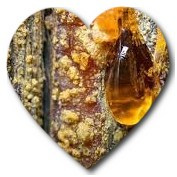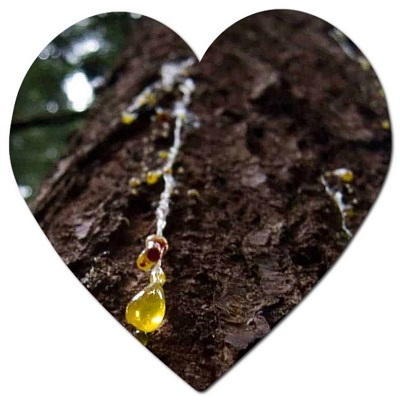Several tree species in Canada produce resin, also known as tree sap or tree gum. Here’s a brief description of some of the trees that grow resin in Canada: Pine Trees: Various pine tree species, including white spruce, black spruce, and lodgepole pine, produce resin in Canada. Pine resin is often used for its adhesive and aromatic properties. Fir Trees: Balsam fir, a common tree in Canada, produces resin. Balsam fir resin is known for its fragrant scent and traditional medicinal uses. Spruce Trees: White spruce and black spruce are common in Canada and produce resin. Spruce resin is used for its sticky, adhesive qualities. Tamarack: Tamarack, also known as the American larch, produces resin in Canada. Tamarack resin has traditional uses and is native to the country. These trees produce resin with various properties and applications, including adhesive, wound care, incense, and more. The specific type of resin and its uses can vary depending on the tree species and the region in Canada.
Resin, often referred to as tree sap or tree gum, can be found in various tree species in Canada. Some of the common trees that produce resin in Canada include:

- White Spruce (Picea glauca): White spruce trees, a common conifer in Canada, produce resin. They are found in various regions across the country.
- Black Spruce (Picea mariana): Black spruce trees, especially prevalent in northern Canada, also produce resin.
- Balsam Fir (Abies balsamea): Balsam fir is known for producing resin, and it’s native to Canada, particularly in the eastern and northern parts of the country.
- Ponderosa Pine (Pinus ponderosa): In some parts of western Canada, particularly British Columbia, ponderosa pine trees produce resin.
- Lodgepole Pine (Pinus contorta): Lodgepole pine is another pine species found in Canada, and it can produce resin.
- Tamarack (Larix laricina): Tamarack, also known as the American larch, is native to Canada and can produce resin.
- Eastern White Pine (Pinus strobus): Eastern white pine trees, while more commonly found in the eastern United States, can also be found in some parts of eastern Canada and produce resin.
These are just a few examples of tree species in Canada that produce resin. Resin from these trees may have various traditional and practical uses, including as adhesive, incense, wound care, and more. The uses and properties of resin can vary depending on the tree species and the region in which it is collected.
Can you collect resin in Canada?
In Canada, the collection of tree resin, also known as resin, sap, or gum, is generally permitted, but there are some important considerations and regulations to be aware of when collecting resin from trees:
- Private vs. Public Land: If you plan to collect resin, it’s crucial to be aware of whether you are on private or public land. On private property, you may need the landowner’s permission to collect resin. In national parks, provincial parks, or other protected areas, there may be specific regulations regarding the collection of natural resources, including resin. Always check with the relevant authorities to ensure compliance with any local or regional rules.
- Sustainable Harvesting: When collecting resin, it’s important to do so in a sustainable and responsible manner. Avoid damaging the tree or taking excessive amounts of resin, as this can harm the tree and its ecosystem. Collect only what you need, and consider the ecological impact of your actions.
- Tree Species: Different tree species produce resin, so be sure to identify the trees correctly. Pine trees, spruce, fir, and other conifers are common resin-producing trees in Canada.
- Tools and Safety: Use the appropriate tools and safety equipment when collecting resin, such as a knife, container, and gloves. Exercise caution to avoid injuring yourself or the tree.
- Processing and Cleaning: Resin collected from trees may contain impurities or debris. It’s advisable to clean and purify the resin to remove any contaminants before using it.
- Local Regulations: Be aware that local regulations and guidelines may vary depending on the province or territory in Canada. Always check with local forestry authorities or conservation agencies for specific guidelines and permits that may apply to your area.
- Respect for Nature: Resin collection should be done with respect for nature and the environment. Leave no trace of your activity and avoid causing harm to the trees or surrounding ecosystems.

It’s important to be informed and follow responsible practices when collecting tree resin in Canada to ensure that you do so legally and sustainably. Before collecting resin, it’s a good idea to consult with local authorities or forestry agencies for guidance and to check for any specific rules or permits that may apply to your location
Is resin good for health in Canada?
Resin collected from certain trees, such as pine resin, may have various traditional and potential health-related uses in Canada and around the world. However, it’s important to note that the health benefits and safety of using resin can vary depending on its source, quality, and specific application. Here are some potential health-related uses of resin and considerations in Canada:
- Traditional Medicine: Resin has been used in traditional medicine for its potential wound-healing properties and as a natural remedy for minor cuts, scrapes, and skin irritations. It is often applied topically to clean wounds and promote healing. It is advisable to use resin after proper processing and purification to remove impurities.
- Aromatherapy: When burned as incense, resin can release aromatic compounds that are believed to have therapeutic properties in aromatherapy. The soothing, woodsy fragrance of resin is thought to promote relaxation and a sense of well-being.
- Antimicrobial Properties: Some resins, including pine resin, are believed to have natural antimicrobial properties that can help prevent infection when applied to wounds. These properties can be beneficial for maintaining good health.
- Skin and Cosmetic Products: Resin may be used as an ingredient in some natural and cosmetic products, such as salves, balms, and soaps, for its potential skin benefits.
- Caution and Allergies: It’s important to exercise caution when using resin on the skin, as it can cause skin irritation or allergies in some individuals. Before applying resin to a larger area, conduct a patch test on a small, inconspicuous part of the skin to check for any adverse reactions.
- Consult a Healthcare Professional: If you have specific health concerns or conditions, it’s advisable to consult with a healthcare professional or dermatologist before using resin-based products on your skin or for medicinal purposes.
The use of resin for health-related purposes should be done with care and consideration of the quality and purity of the resin. In Canada, as in other countries, it’s important to use resin responsibly and ensure that it is properly processed and filtered to remove impurities. Additionally, it’s essential to be informed about the potential uses and benefits of resin and to seek professional guidance if needed, especially if you have specific health concerns.
